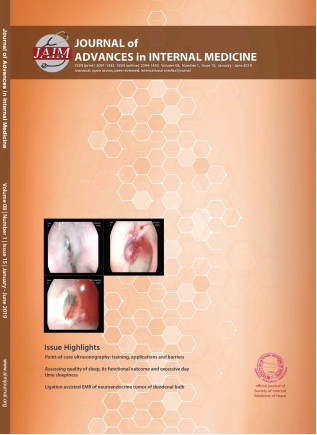Pattern of glomerular diseases in biopsy proven native kidney in Western Nepal
DOI:
https://doi.org/10.3126/jaim.v8i1.27998Keywords:
IgA, Nephropathy, kidney biopsy, sub-nephrotic proteinuriaAbstract
Background and Aims: Kidney biopsy is decisive while evaluating for the diagnosis of glomerular, vascular, tubulointerstitial and genetic diseases. There is paucity of data on prevalence and pattern of various types of kidney diseases in Nepalese population. We describe various types of kidney diseases in patient population undergoing kidney biopsy at our centre.
Methods: This is a prospective analysis of all patients, who underwent percutaneous renal biopsy at Manipal teaching hospital, over a duration of 30 months, i.e. August 2017 to January 2019. All kinds of kidney disease patients were included for kidney biopsy, irrespective of their clinical syndromes and underlying diagnosis.
Results: A total of 175 consecutive biopsies were analyzed. The mean age of the patient was 35 } 15 years. Majority of the biopsy performed were in females. The majority of biopsy cases were age between 21-30 years of age. The youngest case to undergo renal biopsy was a child with asymptomatic isolated hematuria. The most frequent histological pattern observed in our study was IgA nephropathy (34.6%), followed by Focal segmental glomerulosclerosis (15.45%) and Membranous nephropathy (14.85%). Regarding complication macroscopic hematuria was seen in 15 (8.5%) cases and 8 (4.5%) cases had perinephric hematoma. There was no death related to renal biopsy.
Conclusion: IgA nephropathy was the commonest histological pattern. Subnephrotic proteinuria was the commonest indication for biopsy. Complication of kidney biopsy is rare and considered safe procedure in clinical practice to determine diagnosis, prognosis and treatment.
Downloads
Downloads
Published
How to Cite
Issue
Section
License
This license enables reusers to distribute, remix, adapt, and build upon the material in any medium or format, so long as attribution is given to the creator.




